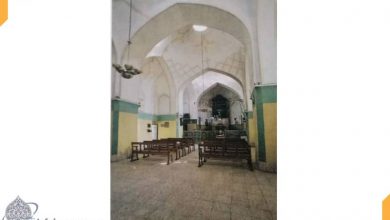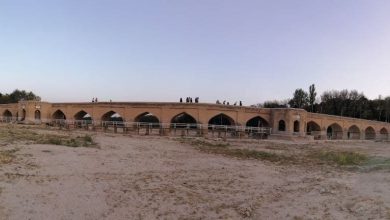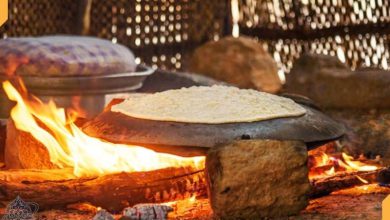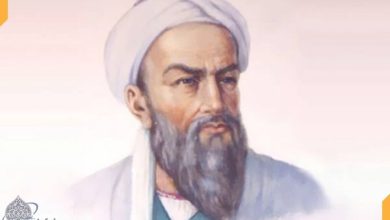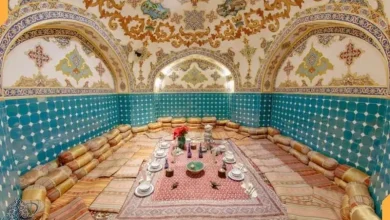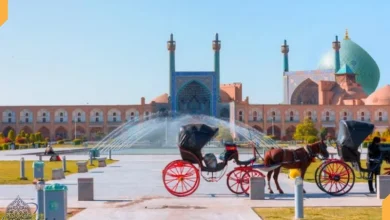Sheikh Lotfollah Mosque in Isfahan

Sheikh Lotfollah Mosque hasn’t any minaret. Of course, the wonders of it, don’t end to this, that in the following of this article, in addition to stunning photos of different parts of the mosque, we address to the beauties and the readable contents about that.
The introduction of Sheikh Lotfollah Mosque
Sheikh Lotfollah Mosque, which is located in Naghsh-e Jahan Square of Isfahan, was included in the list of national monuments of Iran on January 6, 1961, and with its extraordinary architecture, tiling and decorations, displays one of the most beautiful and the best manifestations of the art of the Safavid period.
This magnificent building, which is considered one of the spectacular places of Isfahan, has been shining in front of Ali Qapu palace and the eastern side of Naghsh-e Jahan Square for centuries and attracts the attention of every internal and foreign tourist.
Professor Mohammad Reza Isfahani was one of the most famous architects of the Safavid era, who was able to complete the Isfahani style of architecture as beautifully as possible in this place.
According to the Sputnik news agency, this artwork is considered one of the seven unknown wonders and the highest spectacular structures in the world.
Sheikh Lotfollah Mosque is very different from other Iranian mosques
in a way that, not only it doesn’t have any minarets, but there is also nothing going on with the apron, dormitory, and yard of the four porches, that this issue confirms the exclusive structure of Sheikh Lotfollah Mosque.
The design of this mosque is very skilful and professional, and the sizes are in perfect proportion, and there are no weaknesses seen in it.
One of the characteristics of most mosques in Isfahan is the seven-time reflection of sound; the same is true in the Sheikh Lotfollah Mosque, which adds to its unique attributes.
The inscriptions and lines inside the mosque, are artistic works by two calligraphers of the Shah Abbas era, namely Alireza Abbasi and the anonymous calligrapher, Baqer Bana, who have given extra beauty to this mosque.
It is interesting to know that the design of gardens and flowers in Tehran’s Azadi Square is inspired by Sheikh Lotfollah Mosque; of course, with this difference that its architect, Hossein Amanat, has used an oval pattern for the Azadi Square, instead of a circular design in the dome of the mosque.
Read More; Great Mosque of Isfahan
The appellation of This Mosque
Denominating of this mosque is on the occasion of the name of its congregational Imam, namely Sheikh Lotfollah ben Abdul Karim bin Ibrahim, who migrated to Iran from Jebal Amil of Lebanon for religious reasons, during the reign of Shah Abbas and at first, settled in Mashhad and this
After seeking grace from the presence of scholars, including Mullah Abdullah Shoushteri, served Astane Razavi on behalf of Shah Abbas, the Great and resided in that city until the date of the Uzbek’s sedition and his conquer over Mashhad, then he had sought refuge in Qazvin to get rid of him and began teaching there;
Shah Abbas brought him from Qazvin to Isfahan and in 1011 A.H, he established the Ayatollah Masjid, which is still known by his name, to be his place of teaching, residence, and Imamate, and this was done until 1028 A.H.
it was during the completion of this building that Shah Abbas in the southern part of Naghsh-e Jahan Square, now called Imam Shohreh Square, laid the plan for the construction of the Grand Mosque, called Sheikh Lotfollah Mosque. In fact, this was done after Sheikh Lotfollah Mosque was prepared for his praying.
This mosque was named after Mullah Fathollah in the following of the Safavid period and was later called Sadr Mosque (Sadr or Sadr al-Ulama was used to refer to Mojtahed-e Alam or the Marja-e Taghlid), but today it is known by the first name.
On the other hand, Sheikh Lotfollah was the father-in-law of Shah Abbas. Therefore, a mosque and a school were built in the Sheikh’s place of residence that was named after him, where he taught jurisprudence courses and hold religious meetings.
The Sheikh performed the Friday prayers in this mosque and his followers also imitated him.
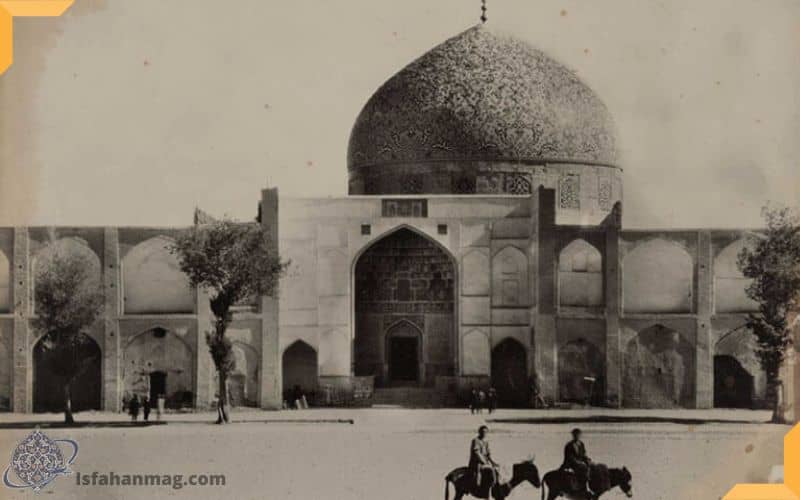
The Short History of Sheikh Lotfollah Mosque
Isfahan was the capital of the Safavids in 982 A.H and was lived at the peak of the development of constructions such as Chaharbagh Street, Naghsh-e Jahan Square, Imam Mosque, etc.
It was at this time that Shah Abbas ordered the construction of the Sheikh Lotfollah Mosque and therefore, they started the foundation of a new mosque on the ruins of another mosque located at the same location.
Mohammad Reza Isfahani took charge of the construction of this mosque, which was able to build an amazing building in a time of 18 years.
Sheikh Lotfollah Mosque was allocated only to Shah Abbas and the royal family, and ordinary people were not allowed to enter it. It seems that Shah Abbas used to worship in this mosque, every day from the opening of the mosque in 998 A.H until the end of his life.
There is no exact information about the fate of Sheikh Lotfollah Mosque over time; however, according to the historical sources, this mosque had other names during the Safavid period, such as Mullah Fethullah and Sadr, which was later called the same Sheikh Lotfollah.
According to the writings of Arthur Pope, an American Iranologist, he asked Reza Shah to order the restoration of the mosque, and he agreed, and in the following, the original plans the entrance tiles, and also the dome was rebuilt.
The inscription on the exterior view of the dome indicates that the building was restored in 1315 by the Archaeological Department.
Who is Sheikh Lotfollah?
Sheikh Lotfollah was one of the greatest Shia scholars, who lived in the Jebal Amil area of today’s Lebanon. He came to Iran to live with the invitation of Shah Abbas I along with some of the great persons of Shia.
At first, Sheikh Lotfollah went to Mashhad and studied in the presence of great people such as Mullah Abdollah Shoushteri and finally, was selected to serve in Astan Quds Razavi.
He then went to Qazvin to teach there. Because of Shah’s devotion to him, he ordered the construction of the mosque to be a place for education, teaching and praying.
Sheikh Lotfollah was in charge of performing Friday prayers in Sheikh Lotfollah Mosque until he got sick in 1035 A.H and passed away in Isfahan.
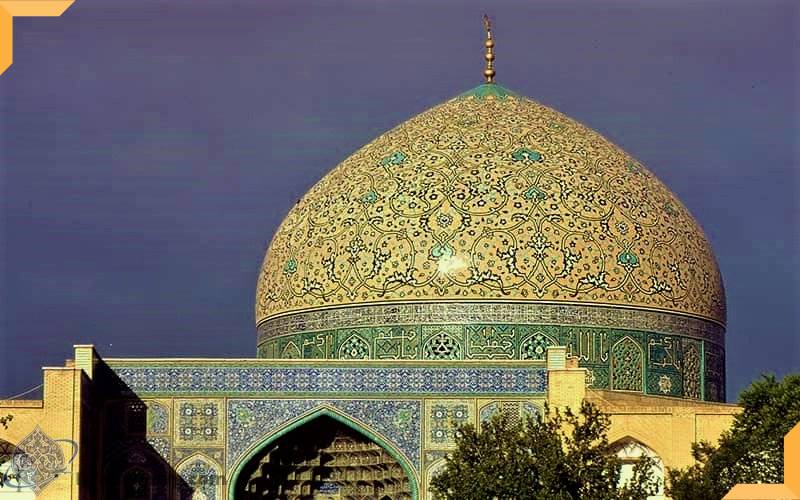
The architecture of Sheikh Lotfollah Mosque
The architecture of Sheikh Lotfollah Mosque, which is in the Isfahani style, shows the profession and ability of Isfahani architects; especially its dome, which is one of the most beautiful domes in the world.
The architecture of Sheikh Lotfollah Mosque is in Isfahani style
One of the interesting things about the mosque is the lack of an entrance dormitory; In fact, when you enter the mosque, you have to go through a series of stairs and then enter an entrance apron that leads you to the dome space;
What is obvious in the Sheikh Lotfollah Mosque, is the absence of this entrance apron or dormitory, which had intended to observe the principle of symmetry in Naghsh-e Jahan Square.
As this mosque is located in front of Ali Qapu, it was not possible to place a yard or apron facing the Qibla.
In the design of the mosque, the golden ratio has been used to establish the appropriateness of the building components and the position of its main dormitory had been determined in relation to the entrance of the building with geometric methods.
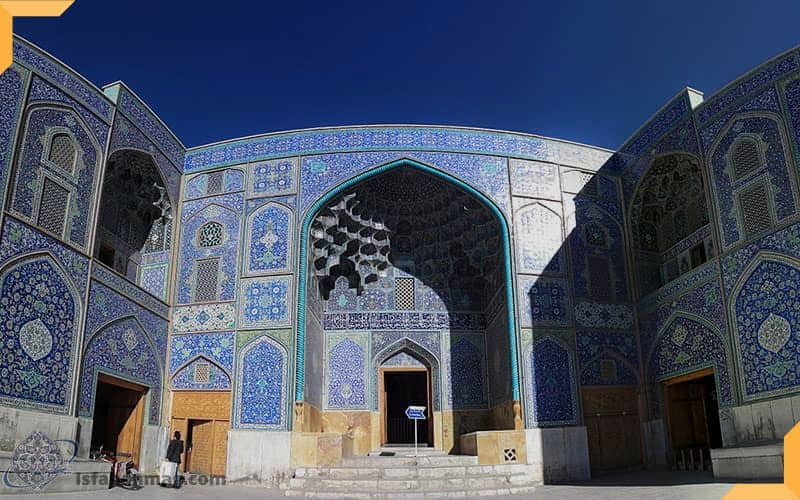
The entrance of the mosque
The front space of the entrance starts from the eastern side of Naghsh-e Jahan Square the location of it was led to the division of this side of the square with a golden ratio.
The northern and southern parts of this space, as well as the wall facing the western square of the mosque, are covered with seven-colour tiles.
The forecourt of the mosque was white when Andre Godard wrote the book “Iranian Works”;
10 years before this book was written, the frontcourt tiles were moved to the basement due to the damage, and the current view is the result of the efforts of the restorers.
The book “Nesf-e-Jahan fi Tarif Isfahan” also emphasizes that the current mosque doesn’t have any defection yet, except the inscription on the portal, which couldn’t get repaired and replaced.
The inscription above the portal is decorated with mosaic tiles that surround all three walls in the form of a continuous strip.
This large inscription is written by Alireza Abbasi with his calligraphy in white and shows the year 1012 A.H.
The upper parts of the portal are also decorated with Mogharnas (arched), tiles of seven colours, and flower and vase designs.
Above this inscription and in the arch of the vault, you will see Shamseh stalactite vaulting with a blue background.
In addition, your attention is drawn to the spiral turquoise tiles that surrounded the edge of the main arch of the portal.
After crossing it, you would reach the portal area bypassing four steps. The bottom walls of this place are decorated with yellow marble; in addition, the platforms of the same stone are located on the sides.
For the two pairs of doors of the mosque, the integrated plane wood had been used, which is still standing after 400 years.
There was an octagonal pool in front of the mosque, which was removed between the years of 1316 and 1318 A.D.

The Entrance corridor
The 28-meters corridor at the entrance of the mosque, at first turns to the left and then to the right, and finally, leads to the main area under the dome.
This rotation of the corridor causes a kind of circumambulation around the main apron.
In fact, this corridor, by creating a sense of spiritual tranquillity and separating the noisy world of the urban space from the inside of the mosque, prepares you for worshipping God.
Before reaching the second turn, you will see a door on your left side that leads to the winter dormitory. This dormitory has a short roof and a simple design and was used for praying in cold seasons.
14 meters from the corridor, you should turn to the right; where the corridor is at a 90-degree angle.
This corridor has relatively little light and is illuminated by light beams that shine through the reticular window on the right.
For this reason, you don’t see much at the time of entrance, because you have entered this dim environment from a bright place, but after a few moments, your eyes get used to it and you can enjoy the corridor patterns, which are decorated with seven-colour tiles, that are often green and blue.
This corridor helps you to get used to low light and do not enter the semi-dark dormitory of the mosque suddenly, and you can understand its beauty heartily.
The main dormitory
The main dormitory of Sheikh Lotfollah Mosque can be considered the culmination of the glory and beauty of this mosque, which amazes you with its art and spirituality.
This dormitory is a square with sides of 19 meters and after moving away from the ground and rising, it becomes octagonal and when it reaches the stem of the dome, it transforms into a circle.
This conversion plan from the square to a circle is one of the important architectural features of the Sheikh Lotfollah Mosque, which was remembered from the Sassanid period.
When you look at the roof of the dormitory, you will see eight zigzag arches across the dormitory that support the dome and have impressive Mogharnas (vaulted) that are beautifully decorated with turquoise spirals at the edges of the dormitories.
In the corner of this dormitory, artistic decorations from geometric patterns to flower and plant designs, peacocks, etc.
can be seen in the form of seven-colour tiles in the lower parts and mosaic tiles in the upper parts. Among these decorations, there are inscriptions in Nastaaligh Font and manuscripts that have completed all this beauty.
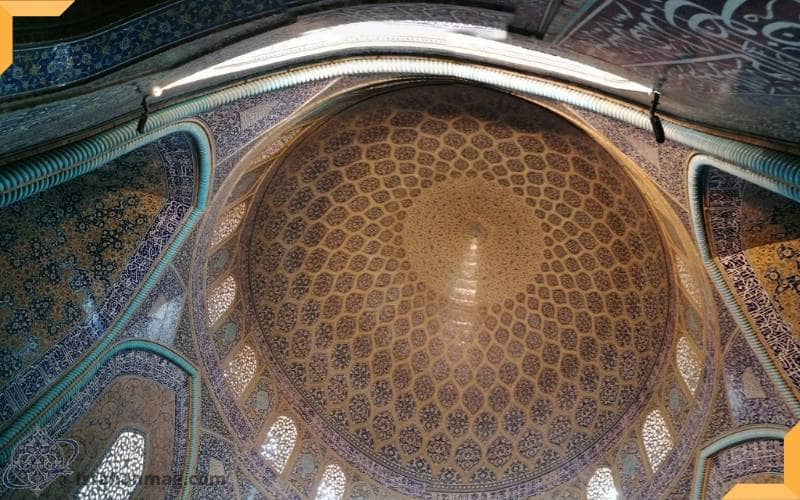
The direction of the building toward the Qibla
According to Iranian-Islamic architecture, when people enter the dormitory of the mosque, they are settled in the direction of the Qibla; an event that doesn’t happen in the Sheikh Lotfollah Mosque.
In fact, Naghsh-e Jahan Square is not in locating the direction of Qibla, so the architects used a 45-degree rotation to build this mosque to adjust the mosque in the direction of Qibla;
at the same time, they performed this method with such delicacy that no curvature or angle can be seen in its exterior view.
It is located at the entrance of the mosque, on the eastern side of Naghsh-e Jahan Square and on the northern-southern axis.
The architects couldn’t build the mosque in line with Naghsh-e Jahan Square, because they had a lot of problems in finding the Qibla and building an altar that was located in the southwest direction and facing the Qibla.
To solve this problem, they considered a corridor that was extended from the entrance of the mosque to the space under the dome;
however, they designed this corridor with a 45-degree angle. Thus, the appearance of the mosque is in a northern-southern direction, but the main building is located in the southwest-northeast direction.
Why the Sheikh Lotfollah Mosque doesn’t have any minarets?
One of the issues that draw attention to Sheikh Lotfollah Mosque at the first glance is the lack of minarets, in the same way, it is different from other mosques in the Islamic world since the minaret is an important and also the main part of the architecture of mosques.
The function of the minaret was basically used in pre-Islamic times to navigate the buildings and also indicated the existence of a city.
However, after Islam, it became a sign of a mosque and a place for the call to prayer.
Since Sheikh Lotfollah Mosque was built solely for the worship of the Shah and his family and was not used by ordinary people, there was no need to build a minaret for it.
For this reason, this magnificent and beautiful mosque received less attention from tourists and, consequently, remained unknown compared to other places of interest in Isfahan.
It is very interesting to pay attention to different angles in Safavid designs; especially in the architecture of Isfahan, a clear example of which can be seen in the lack of a minaret for the Sheikh Lotfollah Mosque, which in this way, has practically separated the court families from the general public.
There is another narration that the architects consider the dome as a symbol of woman and the minaret as a symbol of man.
The presence of the dome alone in this mosque shows that this mosque was built exclusively for women. Some narrations say that this mosque was also a harem.
However, there is no certainty about this and the reasons for the lack of a minaret are still unknown.
There is also a narration that a minaret was not built for this mosque because it had a view of the inside of Ali Qapu from the top of the minaret, and this narration also hasn’t validity.
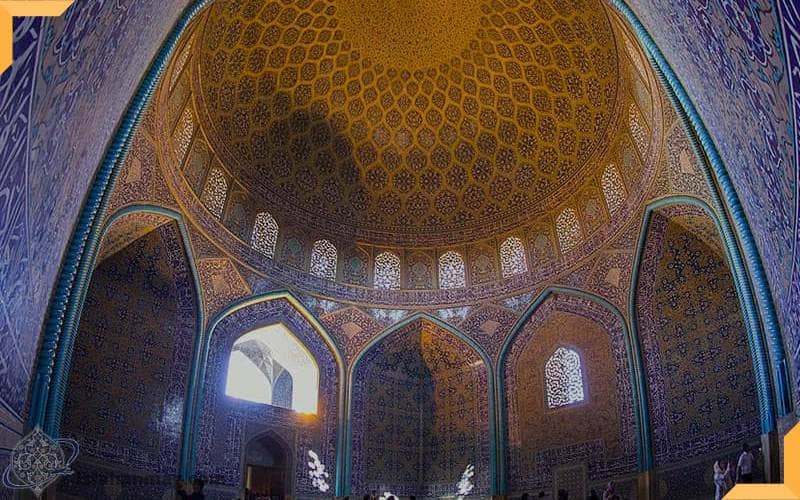
The Dome of Sheikh Lotfollah Mosque
The magnificent dome of Sheikh Lotfollah Mosque is in the form of two connected shells that the height of the top of the dome to the ground level is about 32 meters, its opening is 12 meters and its outer diameter is 22 meters.
This dome is lower than the dome of other mosques, which is undoubted, more difficult to build than ordinary domes.
During its construction, the architect of this building had thickened the walls adjacent to the dome to be able to withstand the weight and pressure of the dome.
The dome of the mosque is located on eight truncated arches, and above these arches, 16 reticular windows can be seen, that are located apart at a distance of 170 cm and help the air conditioning.
While each of these windows is decorated with Arabesque traceries, this matter causes light refraction and indirect lighting.
During the day, part of the sunlight enters the mosque through these windows and creates a spiritual atmosphere.
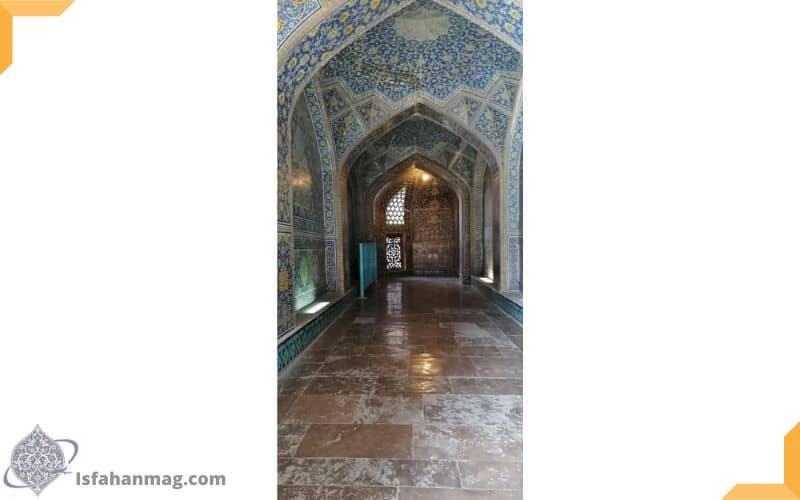
The pattern of the peacock is one of the most interesting interior parts of the Sheikh Lotfollah Mosque
In the distance between these windows, inscriptions decorated with verses of Surah Al-Nasr and Al-Jumua have been installed.
The stem of the dome is decorated with blue tiles and floral and plant motifs, and there are two large inscriptions in the belt inside the dome with the calligraphy of Reza Abbasi:
The inscription of the first belt is a description of the etiquette of entering the mosque from the words of the Prophet of Islam, at the end of which it is written: “Kotobha ala Reza Abbasi fi 1025 (Books of Ali Reza Al-Abbasi in 1025)”.
The second belt inscription contains all the verses of Surah Al-Jumua and Surah Al-Nasr that end with this statement: “Kotobha ala Reza Abbasi Ghaffar Allah Zunubah (Books of Ali Reza Al-Abbas, God forgives him)”.
One of the most interesting parts of the dome can be known as the inner centre dome, which is composed of rhombus motifs, and when light shines on it.
the shape of a peacock’s feathers shows itself and over time, with changing the direction of radiation of light, the feathers of this peacock get open over time and gradually get closed.
This is important because although drawing animal shapes in mosques is not allowed, this work has been achieved with beautiful elegance and with the help of light in Sheikh Lotfollah Mosque.
These 32 rhombus patterns are put together in such a way that get smaller when they go towards the centre of the dome.
In fact, it can be said that that 4 walls to the 8 sides, 8 to 16 windows and 16 became 32 pictures and it launched a good game with the help of numbers.
It has been set up and with this method, it has been tried to make the height of the dome look higher.
The attractions of this dome cannot be summed up here, and the mosaic tiles used inside it, have multiplied the beauty of this dome; especially that in the effect of the radiation of sunlight, they have a very beautiful effect.
One of the reasons that mosaic tiles get more attractive is the height under the dome if it were more, the light would not reach the tiles, and such an effect would not be created.
The outer part of the beautiful and huge dome of Sheikh Lotfollah Mosque comes in various colours at different times of the day; as at aurora, you can see pink, a kind of white at the noon, and a brick-like colour at the sunset.
The design of the dome of the mosque is made in the shape of an octagonal star that leads to the top of the dome with a gentle slope.
The outer part of the dome is decorated with mosaic tiles with a pea-coloured background, in the lower part of which there are inscriptions of Quran sura with Suls script are forming an impression on an azure background.
There is an octagonal star at the highest point of the dome and magnificent Arabesque lines can be seen on the surface of the dome.
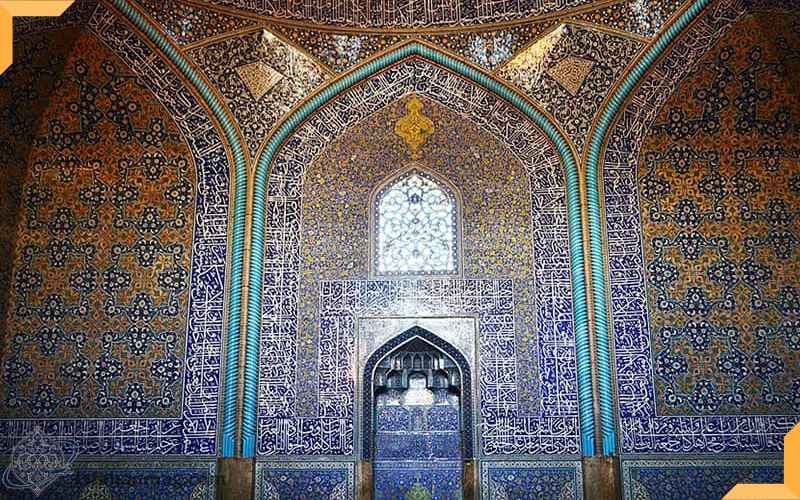
The Altar of Sheikh Lotfollah Mosque
The altar of Sheikh Lotfollah Mosque, like other parts of it, is one of the unique architectural masterpieces, and thanks to the mosaic tiles and elegant stalactite vaulting, it catches the attention of every viewer.
The altar has a serrated arch which is decorated with shelly stalactite vaulting and plant motifs and Arabesque motifs can be seen above it.
The beautiful color that is used and also the utilization of patterns and decorative lines have made the altar one of the most attractive parts of Sheikh Lotfollah Mosque, but this is not all, and there is an opening above the entrance to the dormitory, which doubles the beauty of the space by directing light to the altar.
There are two tablets with this statement: “Poor humble deed in need of God’s mercy Mohammad Reza Ibn professor Hussein Banai Isfahan” inside the altar.
In addition, there are inscriptions around the altar which are written by Alireza Abbasi, and in addition to a narration of the Holy Prophet (PBUH) and the sixth Imam (AS), there are also poems attributed to Sheikh Baha’i on them.
The underground corridor of Sheikh Lotfollah Mosque
According to historical evidence, there is an underground corridor under Naghsh-e Jahan Square that connects Ali Qapu and Sheikh Lotfollah Mosque, and since this mosque was used by women, they used this corridor for going back and forth.
It is said that Sheikh Lotfollah taught religious issues to Safavid women in this mosque.
Today, due to the construction of a large pool in Naghsh-e Jahan Square, the two parts of this corridor are no longer connected.
Experts believe that it is possible to revive this passage; of course, on the condition that the pool is no longer in the middle of the square.
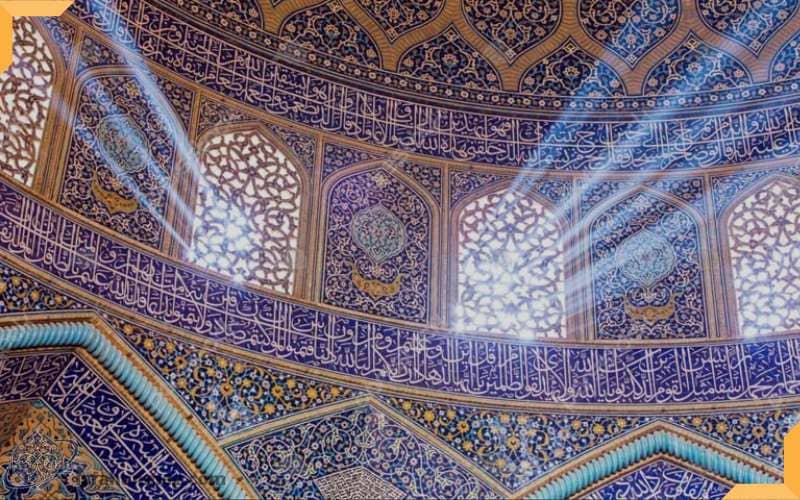
The light in Sheikh Lotfollah Mosque
The lighting mechanism in Sheikh Lotfollah Mosque shows as well that Mohammad Reza Bana Esfahani had complete mastery over the subject of light and its complexities, and for this reason, the lighting of this mosque is different from other mosques.
By placing two reticular windows under the dome, the holes of which do not oppose each other, he caused the light to break twice before entering the mosque.
This defeat captures the sharpness and victory of light and creates a spiritual atmosphere. This soft light fits the shape of the dome, the curved lines of the patterns, and the light blue colours of the structure.
Behnam Tajmir Riahi, a cinematographer and lighting designer who has researched the importance of light in this mosque, says:
“Due to the intense light of Naqsh-e Jahan Square, which is caused by the ever-shining sun of Isfahan, the eye’s pupil gets narrows.
when we enter the corridor of the entrance of Sheikh Lotfollah Mosque from this bright environment, due to visual shock, the narrow eye‘s pupil cannot withstand the darkness of the mosque, and we see nothing but darkness.
Therefore, time and conditions must be provided for the eye’s pupil to get dilate and adapt to the new environment.
The dark entrance hall of the mosque contributes to this, although the provincial cultural heritage authorities have installed lamps in this corridor, eliminating this deliberate darkness.
Then, as our eye’s pupils get open and adapt to the darkness, we enter the second corridor, which also emits light to guide our eyes through the lattice window in the middle on the left.
When we reach the entrance of the space under the dome, our eyes are accustomed to the darkness and we are ready to see the details of the tiles of this space and the play of the light and darkness inside it.”
Interestingly, the Quran verses on the outer wall of the mosque are perfectly proportional to the angles of light and sunlight, so that with the radiance of sunlight at any hour of the day, a verse is displayed and during the day, the sun shines on other verses of the Quran.
The tiling of Sheikh Lotfollah Mosque
The tiling of Sheikh Lotfollah Mosque is one of the architectural wonders of the Safavid era from the exterior of the mosque to the corridor, the dormitory, and the altar catching the attention of every viewer. Special details and skills have been used in these tiles, which look very beautiful along with the light dance. The tile decorations inside the mosque above the plinths are all mosaic tiles.
The upper parts of the entrance door in addition to stalactite vaulting, are decorated with unique seven-colour tiles with floral and vase designs.
There is a large inscription of azure mosaic tiles in the middle of the entrance, on which the beautiful, white Suls line of Alireza Abbasi is engraved.
As you walk down the aisle of the mosque, you will encounter another scene of seven-coloured tiles, the predominant colours being blue and green.
The dormitory also has many tiling decorations; as you turn your head in any direction, you will see seven-coloured tiles and mosaics that will definitely fascinate you.
Spiral turquoise tiles are also the culmination of this story, which make the glory of this dormitory more and more and are a good subject for photography.
It is impossible to write about this mosque and not to mention its spectacular altar, which attracts attention due to its mosaic tiles.
Inside and outside the dome of the mosque are covered with mosaic tiles, which in particular the use of natural light and beautiful colours inside the dome, has distinguished it from other mosques in the city.
This dome, which is considered to be the only pea-coloured dome of the Safavid era, changes its colour during the day and has a different appearance in each time period.
In the lower part of the dome, there are inscriptions of Quran verses with white mosaic, and white tiles on an azure background.
The change of the color of the mosque during the day and night
Isfahan has many wonders. Safavid architecture has left many marvels. Sheikh Lotfollah Mosque, with its wonders, amazes all the tourists.
The circular dome is decorated with Arabesque motifs, and it is enough of this art that at different times of the day and according to the angle of the sun, the colour of the dome changes; in the morning it turns dusty, in the afternoon it turns pink and in the evening it turns grey.
This is one of the wonders of this mosque which attracts many tourists from all over the world to this city to watch the colour changing of it.
It is interesting to note that Sheikh Lotfollah Mosque is the only pea-coloured mosque from the Safavid period. All Safavid mosques have a blue dome, but this mosque, unlike them, is a pea-coloured one.
The entrance of this mosque has several steps and the entrance door is made of two pair of sycamore and solid wood, which still stands after 400 years.
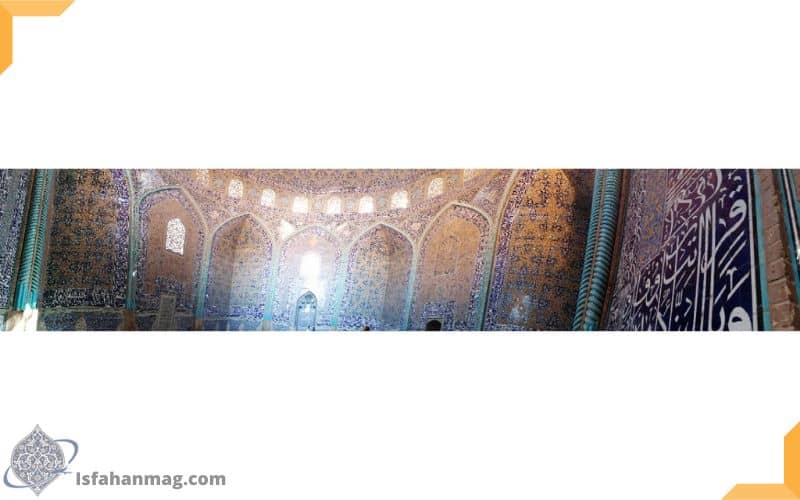
Another unique feature of this mosque is its 45-degree rotation towards the north-south axis and towards the Qibla that in the architectural term, it is called “Pivot”, but this building is so elaborately built that there is no trace of skew in it.
To correct this angle, a beautiful hallway has been created with colourful tiles, which predominant colours are green and blue. This path turns left at the first entrance and then to the right.
After passing through this corridor, you will reach the main area under the dome, which is a little higher than the ground.
Facing the magnificent art of dark blue on a white background with beautiful peacock patterns that are designed in the centre of the dome and its feathers are completed by light entering from the upper arch of the entrance door of the mosque.
The difference between Sheikh Lotfollah Mosque with other mosques
For several reasons, experts consider this mosque different from all other mosques:
1- Lack of minaret on top of the Sheikh Lotfollah Mosque
At the first glance, what draws people’s attention to the mosque, is the lack of minarets next to the dome, while in all mosques, the minaret is an integral part of the architecture.
Before Islam, the minaret was built as a navigator on buildings, and the existence of the minarets indicated the existence of a city.
After the advent of Islam, the minaret and the crown of the mosque became a symbol of the mosque and were used to recite the call to prayer and invite people to pray, but since Sheikh Lotfollah Mosque was a place of worship for the courtiers and the Shah’s family, a minaret was not built on top of it, so that the public would not come to this mosque.
Even in the writings of the tourists who visited Isfahan during the Safavid period, not much is said about this mosque, and this can be due to two reasons:
Next to Sheikh Lotfollah mosque, there is another masque called Imam Mosque that has received more attention due to its size and grandeur.
Sheikh Lotfollah Mosque was the private space of the courtiers and no one was allowed to enter it.
2- Lack of dormitory and existence of stairs
This mosque does not have any minarets, but the other difference from it other mosques, is the lack of the existence of an entrance dormitory (yard) and it is possible to enter it through stairs.
It seems that the lack of a dormitory or entrance Apron is due to the observation of the symmetry in Naghsh-e Jahan Square, because this mosque is located exactly in front of the Ali Qapu mansion, and this has made it impossible to design an Apron or a yard facing the Qibla that can be useful for prayer.
The lack of a minaret and apron has caused a portico covered with beautiful and prolific tiles be a factor to connect the space of the mosque to the dome.
3- Existence of a hidden corridor
It has been said that in order for the Shah to reach Sheikh Lotfollah, an underground road was built that allowed the Shah to meet with this scholar. This corridor is located between Ali Qapu Palace and the mosque and it is closed today.
The direction of the building towards the Qibla
One of the distinctive features of Sheikh Lotfollah Mosque is its 45-degree rotation to the north-south axis that idiomatically it is called “Pivot”.
In Iranian-Islamic architecture, mosques are in a way that people face the Qibla when entering the dormitory, but the entrance door of Sheikh Lotfollah Mosque opens to the east side of the square, and if the mosque had been built that way, there would have been problems in orienting the Qibla.
In order to solve this problem, a corridor has been created in the building that extends from the beginning of the mosque entrance to the left and then, turns to the right.
This means that in appearance, the building of the mosque is in the east and it is perceived from the outside that its wall is in the direction of north to south, but in the same wall, there is an altar that faces the Qibla.
It is interesting that there is no sign of skew and angle, outside the mosque and the short dome of the mosque doesn’t show any opposite direction or angle due to its roundness.
but as soon as we enter, we notice the rotation of the apron toward the outside because after passing the Dark entrance, we enter a long corridor connected to it and then reach the main space and the area under the dome.
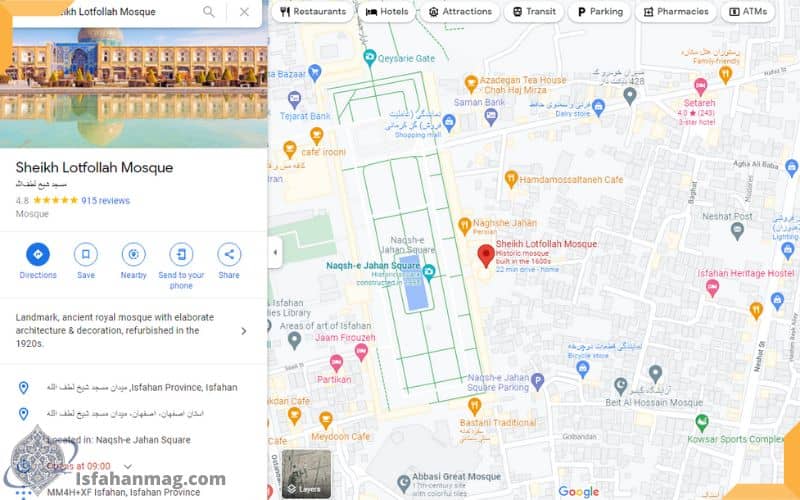
Where is Sheikh Lotfollah Mosque?
Sheikh Lotfollah Mosque is located in the city of Isfahan and the famous Naghsh-e Jahan Square (Imam Square) and is so famous that you can easily find it.
Visiting hours of Sheikh Lotfollah Mosque: Every day, except during midday prayer, in the first half of the year from 9 am to 12:30 and 14 to 17 and in the second half of the year from 9 am to 11:30 and 13 to 16: 30
Address of Sheikh Lotfollah Mosque: Isfahan Province, Isfahan City, East Side of Naghsh-e Jahan Square, in front of Ali Qapu Palace.
The restoration of Sheikh Lotfollah Mosque
The restoration of Sheikh Lotfollah’s dome had accompanied by a lot of criticisms in recent years because its two parts look more prominent than the other and its colour is different from the other parts.
However, the assistant director of the General Directorate of Cultural Heritage, Handicrafts, and Tourism of Isfahan Province defended the issue, saying that the project had proceeded scientifically and also with a plan.
“Fariba Khattabakhsh”, the director of Naghsh-e Jahan Square World Base, also said:
“In April 2016, a part of graving of this complex, which belongs to the Pahlavi period, collapsed and investigations showed that the infrastructure of this grave had problems.
The point is that when it rains on this monument, the materials absorb the water, and during the night the air became very cold, and as a result, the water freezes, and the ice occupies a large volume, causing the materials below and above to freeze.
To repair the grave, all tile pieces were numbered. The mold of the inscription and the grave of the dome was stamped, and the tiles, after number, were placed on the mold in the same pattern as above. The same tiles were put in place after cleaning, decontamination, and washing.”
“Mehdi Rezayat”, the contractor of the restoration project, also stated that the colour contrast of the parts has been repaired and the other parts will be cleared by rain.
Since the slurry was used to leave the dome to prevent water from penetrating and it was not possible to wash it during the restoration, after several spots of rain, the particles on the tiles are gradually washed away and the colours become shiny.
Question and answer:
Why the Sheikh Lotfollah Mosque doesn’t have any minarets?
Basically, the minarets are used to perform the call to prayer and show the existence of a mosque in one place, and since the Sheikh Lotfollah Mosque was not built for ordinary people and only Shah Abbas and his family could use it, there was no need to build a minaret for it.
Where is Sheikh Lotfollah Mosque?
You can visit Sheikh Lotfollah Mosque in Naghsh-e Jahan Square (Imam Square) of Isfahan.
What are the characteristics of the dome of Sheikh Lotfollah Mosque?
In addition to the pea color of the dome, which makes it special and beautiful, the most attractive part of the dome of Sheikh Lotfollah Mosque is the peacock in its interior space and includes 32 rhombuses that become smaller, as you move towards the center of the dome.
What effect does light have on the architecture of Sheikh Lotfollah Mosque?
The architect of Sheikh Lotfollah Mosque has designed different lighting for this mosque with his information about the subject of light. From decreasing the light in the entrance hall to the reticular windows of the dormitory, which leads to the refraction of light and its softening, to the change in the color of the pea dome of the mosque at different hours of the day, all testify to this claim.
The Conclusion:
Sheikh Lotf Allah Mosque is one of the mosques and historical monuments of Iran that became famous for its architectural manner and use of unique decorations.
This building that is located in the Naghsh-e Jahan square, is a unique example of Islamic- Iranian architecture in that the manner of its design has many differences from other mosques of Iran.
These differences have caused the visitors, know this mosque as one of the historical marvels of Iran.
 In which hours of the day do you go to the mosque and how much did you enjoy the sun’s lighting in the corners of the mosque?
In which hours of the day do you go to the mosque and how much did you enjoy the sun’s lighting in the corners of the mosque?
Could you see the design in the interior view of the mosque?

